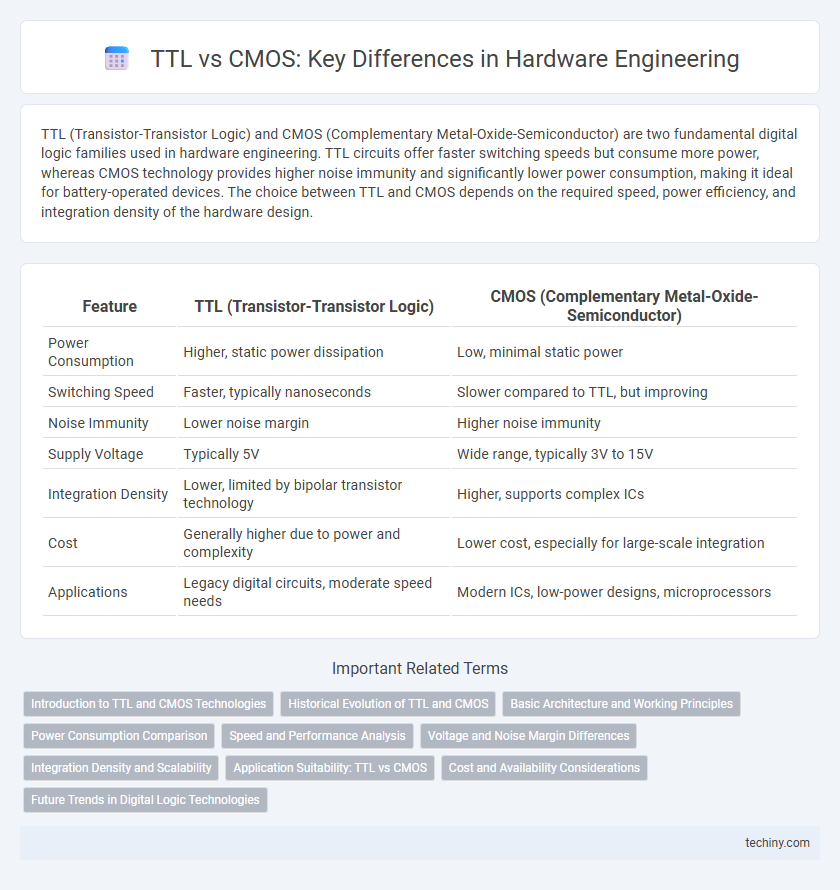TTL (Transistor-Transistor Logic) and CMOS (Complementary Metal-Oxide-Semiconductor) are two fundamental digital logic families used in hardware engineering. TTL circuits offer faster switching speeds but consume more power, whereas CMOS technology provides higher noise immunity and significantly lower power consumption, making it ideal for battery-operated devices. The choice between TTL and CMOS depends on the required speed, power efficiency, and integration density of the hardware design.
Table of Comparison
| Feature | TTL (Transistor-Transistor Logic) | CMOS (Complementary Metal-Oxide-Semiconductor) |
|---|---|---|
| Power Consumption | Higher, static power dissipation | Low, minimal static power |
| Switching Speed | Faster, typically nanoseconds | Slower compared to TTL, but improving |
| Noise Immunity | Lower noise margin | Higher noise immunity |
| Supply Voltage | Typically 5V | Wide range, typically 3V to 15V |
| Integration Density | Lower, limited by bipolar transistor technology | Higher, supports complex ICs |
| Cost | Generally higher due to power and complexity | Lower cost, especially for large-scale integration |
| Applications | Legacy digital circuits, moderate speed needs | Modern ICs, low-power designs, microprocessors |
Introduction to TTL and CMOS Technologies
TTL (Transistor-Transistor Logic) technology uses bipolar junction transistors to implement digital circuits, offering fast switching speeds and robust noise immunity. CMOS (Complementary Metal-Oxide-Semiconductor) technology relies on complementary and symmetrical pairs of p-type and n-type MOSFETs, providing low power consumption and high density integration. TTL circuits are favored for their speed and reliable logic levels, while CMOS excels in low static power dissipation and scalability in modern integrated circuits.
Historical Evolution of TTL and CMOS
The historical evolution of TTL and CMOS highlights TTL's dominance in early digital circuits during the 1960s due to its faster switching speeds and robustness, while CMOS technology emerged in the 1970s offering significantly lower power consumption and higher integration density. TTL, based on bipolar junction transistors (BJTs), initially fueled the development of reliable logic families but faced limitations in scaling and heat generation. CMOS technology, leveraging complementary MOSFETs, revolutionized hardware engineering by enabling complex, power-efficient microprocessors and memory devices that are foundational to modern digital electronics.
Basic Architecture and Working Principles
TTL (Transistor-Transistor Logic) circuits use bipolar junction transistors (BJTs) for switching and amplification, characterized by multi-emitter transistors in the input stage, which enable rapid switching times and moderate power consumption. CMOS (Complementary Metal-Oxide-Semiconductor) technology employs paired NMOS and PMOS transistors arranged in a complementary configuration to minimize power draw during steady states and achieve high noise immunity. The fundamental difference lies in TTL's voltage-driven current flow through BJTs versus CMOS's voltage-driven field-effect transistors controlling charge on capacitive gates, resulting in distinct power efficiency and switching speed profiles.
Power Consumption Comparison
TTL circuits typically consume more power than CMOS circuits due to their constant current flow even when in a steady state. CMOS technology significantly lowers power consumption by only drawing current during switching transitions, making it ideal for battery-operated and low-power applications. The reduced power dissipation in CMOS results from its high input impedance and absence of direct current paths between supply rails during stable logic states.
Speed and Performance Analysis
CMOS technology offers higher speed and lower power consumption compared to TTL, making it ideal for high-performance hardware engineering applications. TTL circuits typically operate at slower speeds due to their bipolar transistor architecture, limiting their efficiency in fast-switching environments. CMOS's ability to switch rapidly with minimal heat generation enhances overall system performance in modern digital designs.
Voltage and Noise Margin Differences
TTL devices typically operate at a 5V power supply with a logic high voltage around 2.4V minimum, while CMOS devices support a wider voltage range from 3V to 15V, offering greater flexibility. Noise margin in CMOS circuits is generally higher due to their rail-to-rail input voltage swings and lower threshold voltages, resulting in improved noise immunity compared to TTL. Voltage level differences impact interfacing; TTL logic levels may not be compatible with CMOS inputs without level shifting, emphasizing the importance of understanding voltage and noise margin when integrating mixed logic families.
Integration Density and Scalability
CMOS technology significantly surpasses TTL in integration density, allowing millions of transistors to be packed onto a single chip, which enhances scalability for complex hardware designs. TTL circuits are limited by their larger transistor sizes and higher power consumption, restricting the number of gates per chip and making them less suitable for large-scale integration. CMOS's low power dissipation and smaller device geometry enable more efficient scaling of hardware systems in advanced semiconductor manufacturing processes.
Application Suitability: TTL vs CMOS
TTL (Transistor-Transistor Logic) is preferred in applications requiring faster switching speeds and better noise immunity, such as in digital circuits with moderate power consumption. CMOS (Complementary Metal-Oxide-Semiconductor) excels in low-power applications and high-density integration, making it ideal for battery-powered devices and complex integrated circuits. The choice between TTL and CMOS depends on the trade-off between speed, power consumption, and integration complexity specific to the hardware design requirements.
Cost and Availability Considerations
TTL (Transistor-Transistor Logic) components generally incur higher manufacturing costs due to their older bipolar technology and increased power consumption, making them less cost-effective compared to CMOS (Complementary Metal-Oxide-Semiconductor) devices. CMOS technology benefits from widespread use in modern integrated circuits, leading to greater availability and lower prices driven by optimized fabrication processes and economies of scale. Availability of TTL parts is limited due to decreased production volumes, while CMOS components remain highly accessible across various suppliers, emphasizing cost-efficiency and supply chain reliability in hardware engineering projects.
Future Trends in Digital Logic Technologies
Future trends in digital logic technologies indicate a shift from traditional TTL (Transistor-Transistor Logic) towards increasingly efficient CMOS (Complementary Metal-Oxide-Semiconductor) due to CMOS's lower power consumption and higher integration density. Innovations in process scaling and 3D integration are enhancing CMOS performance, enabling faster switching speeds and reduced leakage currents essential for advanced computing applications. Emerging technologies such as FinFET and gate-all-around (GAA) transistors further push CMOS capabilities, maintaining its dominance in next-generation digital circuits over TTL.
TTL vs CMOS Infographic

 techiny.com
techiny.com